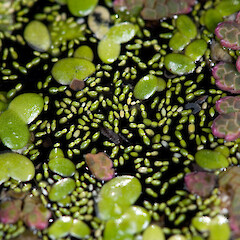Wolffia australiana
Common name
water-meal
Synonyms
Wolffia arrhiza var. australiana Benth.
Family
Araceae
Flora category
Vascular – Native
Endemic taxon
No
Endemic genus
No
Endemic family
No
Structural class
Herbs - Monocots
NVS code
The National Vegetation Survey (NVS) Databank is a physical archive and electronic databank containing records of over 94,000 vegetation survey plots - including data from over 19,000 permanent plots. NVS maintains a standard set of species code abbreviations that correspond to standard scientific plant names from the Ngä Tipu o Aotearoa - New Zealand Plants database.
WOLAUS
Chromosome number
2n = 20, 40
Current conservation status
The conservation status of all known New Zealand vascular plant taxa at the rank of species and below were reassessed in 2017 using the New Zealand Threat Classification System (NZTCS) – more information about this can be found on the NZTCS website. This report includes a statistical summary and brief notes on changes since 2012 and replaces all previous NZTCS lists for vascular plants.
Please note, threat classifications are often suggested by authors when publications fall between NZTCS assessment periods – an interim threat classification status has not been assessed by the NZTCS panel.
- Conservation status of New Zealand indigenous vascular plants, 2017 . 2018. Peter J. de Lange, Jeremy R. Rolfe, John W. Barkla, Shannel P. Courtney, Paul D. Champion, Leon R. Perrie, Sarah M. Beadel, Kerry A. Ford, Ilse Breitwieser, Ines Schönberger, Rowan Hindmarsh-Walls, Peter B. Heenan and Kate Ladley. Department of Conservation. Source: NZTCS and licensed by DOC for reuse under the Creative Commons Attribution 4.0 International licence.
2017 | Not Threatened | Qualifiers: SO
Previous conservation statuses
2012 | Not Threatened
2009 | Not Threatened
2004 | Not Threatened
Distribution
Indigenous. North, South and Chatham Islands. Found throughout the Southern Hemisphere but exact distribution not clear
Habitat
Coastal to lower montane (up to 400 m a.s.l.) in still, fertile, water in sunny situations. Often found in association with Lemna minor L., Landoltia punctata (G.Mey.) Les et D.J.Crawford, Azolla filiculoides Lam., Ricciocarpos natans (L.) Corda and Riccia fluitans L. Easily overlooked.
Wetland plant indicator status rating
Information derived from the revised national wetland plant list prepared to assist councils in delineating and monitoring wetlands (Clarkson et al., 2021 Manaaki Whenua – Landcare Research Contract Report LC3975 for Hawke’s Bay Regional Council). The national plant list categorises plants by the extent to which they are found in wetlands and not ‘drylands’. The indicator status ratings are OBL (obligate wetland), FACW (facultative wetland), FAC (facultative), FACU (facultative upland), and UPL (obligate upland). If you have suggestions for the Wetland Indicator Status Rating, please contact: [Enable JavaScript to view protected content]
OBL: Obligate Wetland
Almost always is a hydrophyte, rarely in uplands (non-wetlands).
Detailed description
Bright green, minute aquatic summer-green herb without roots. Platelets 0.3-1 mm long, bearing one vegetative bud per platelet, ellipsoidal, dorsal surface weakly convex, the central green part merging into a colourless rounded shoulder; submerged portion much larger than that above water, pale, loosely cellular, more or less semi-circular in side view but laterally compressed. Inflorescence in a cavity opening on upper platelet surface; bearing one male and one female flower united without spathe. Ovule 1. Fruit spherical. Seed smooth with prominent operculum.
Similar taxa
None. Could be confused with Lemna and Landlotia from which it differs by its much smaller size, absence of roots, uniformly green colour without red or purple pigmentation, and by the platelets bearing only one vegetative bud
Flowering
November - February
Fruiting
December - April
Propagation technique
Easily grown in a suitable pond, pool or aquarium. During winter it sinks to the bottom sediment, and becomes dormant, returning to surface during warmer weather in late spring and summer.
Etymology
wolffia: Named after Johann Friedrich Wolff, 18th century German botanist and physician
australiana: From the Latin australis meaning southern
Where To Buy
Not commercially available
Attribution
Description adapted from Moore and Edgar (1997).
References and further reading
Moore, L.B.; Edgar, E. 1970: Flora of New Zealand. Vol. II. Government Printer, Wellington.









